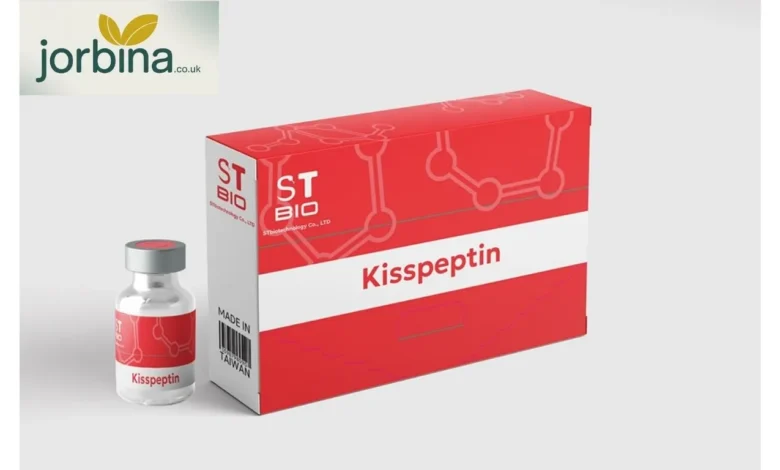Kisspeptin-10 and the Chemistry of Human Bonding

What makes people feel attraction? Why do hormones suddenly surge and set everything in motion, from mood to desire to fertility?
Science points to many factors, but one tiny molecule has quietly been stealing the spotlight: Kisspeptin-10. It’s short, potent, and deeply involved in how our brains and bodies connect.
Let’s take a closer look at what it does, how it works in men and women, what researchers have found so far, and why it might shape the future of hormone science.
The Basics: What Is Kisspeptin-10?
Kisspeptin-10 is a small fragment made up of ten amino acids. It comes from a larger protein produced by the KISS1 gene, which plays a key role in the reproductive system. Despite its small size, this peptide acts like a master switch that turns on several hormonal pathways.
Here’s how it works: Kisspeptin-10 binds to a receptor in the brain called KISS1R (also known as GPR54). Once this receptor is activated, it tells the hypothalamus to release GnRH, the hormone that starts the chain reaction leading to LH (luteinizing hormone) and FSH (follicle-stimulating hormone). Those two then act on the gonads, controlling testosterone, estrogen, sperm production, and ovulation.
Without this signaling, the entire reproductive axis can slow down or even stop. In fact, genetic defects in the kisspeptin system can cause delayed puberty or infertility. So, this isn’t just a “love molecule”; it’s an essential regulator of how human reproduction even begins.
Why Scientists Are Fascinated by Kisspeptin-10

What makes Kisspeptin-10 so interesting is its precision. Instead of flooding the body with synthetic hormones, it stimulates your own natural ones in sequence. Researchers believe this could make treatments safer and more balanced compared to older hormone therapies.
Kisspeptin-10’s potential goes beyond fertility. Studies show it may also affect mood, attraction, and even how our brains process romantic or sexual cues. It’s one of those rare discoveries that connects biology, emotion, and behavior in a single thread.
Kisspeptin-10 Benefits
So what exactly are the potential benefits of Kisspeptin-10? Research is still developing, but several patterns are already clear.
1. Boosting reproductive hormones
Clinical trials in healthy men found that even small doses of Kisspeptin-10 can increase LH and FSH levels, which then raise testosterone naturally. Unlike external testosterone replacement, this approach keeps the body’s internal feedback loop intact.
2. Supporting fertility treatments
Kisspeptin has been tested as a trigger in IVF procedures. Instead of using hCG (which can sometimes overstimulate the ovaries), Kisspeptin may induce ovulation more gently. Early studies suggest this could lower the risk of ovarian hyperstimulation syndrome (OHSS), a potentially serious side effect of fertility drugs.
3. Enhancing sexual desire
Researchers have found that Kisspeptin-10 doesn’t just affect hormones; it also influences brain regions linked to attraction and arousal. In men with low libido, it increased sexual interest and responsiveness. In women with low sexual desire disorder (HSDD), kisspeptin improved emotional response to romantic cues and reduced feelings of sexual aversion.
4. Potential emotional benefits
There’s emerging evidence that kisspeptin might also help balance mood or reduce anxiety related to intimacy. It seems to tune the brain toward more positive, connected responses, though this is still being explored.
5. A safer hormonal reset
Because Kisspeptin-10 activates the body’s natural hormone rhythms rather than forcing artificial ones, it could offer a gentler approach for people whose hormone levels are out of sync due to stress, aging, or medical conditions.
Possible Side Effects of Kisspeptin-10

So far, clinical studies show that Kisspeptin-10 is generally well tolerated. Volunteers given various doses reported no major side effects, no changes in heart rate or blood pressure, and no hormone crashes afterward.
That said, research is still young, and a few points deserve caution. Some people might experience temporary skin redness or irritation at injection sites. Continuous, high-dose exposure could also cause the body to become less responsive, a process called tachyphylaxis, where receptors start ignoring the signal.
Animal studies suggest possible metabolic or cardiovascular changes with long-term use, but these haven’t been confirmed in humans. The bottom line: short-term use in studies looks safe, but long-term data are still limited.
Kisspeptin-10 for Men
Most of what we know about Kisspeptin-10 comes from studies in men. In one clinical trial, even tiny intravenous doses led to a quick surge in LH, and soon after, testosterone. When scientists gave continuous infusions, both hormone levels rose steadily and stayed elevated as long as the peptide was delivered.
For men struggling with low testosterone or suppressed hormone production, Kisspeptin-10 could someday be an alternative to traditional hormone replacement. It doesn’t shut down natural production the way synthetic testosterone can. Instead, it works like a reset button, telling the body to make its own hormones again.
Some men in the performance and bodybuilding world are already curious about it. They see it as a way to support hormonal recovery after steroid cycles or to boost natural testosterone output. While the logic makes sense on paper, there’s not enough long-term human data yet to prove it’s safe for that kind of use.
Kisspeptin-10 for Women
In women, the effects are more complex. The same signal that sparks testosterone production in men can trigger ovulation or influence menstrual rhythm in women, but timing and dose are everything.
When women were given Kisspeptin-10 injections during clinical studies, some showed higher LH and FSH levels, while others didn’t respond much. Researchers think the hormonal phase (where you are in your cycle) plays a big role in how effective it is.
Beyond hormones, Kisspeptin has drawn interest for its potential to reignite sexual desire. In one study of women with HSDD, a kisspeptin infusion changed brain activity patterns related to attraction and reduced negative feelings about intimacy. It didn’t act like a “sex drug”, more like a biological reminder of how attraction is supposed to feel.
In fertility medicine, Kisspeptin may eventually replace hCG as the safer ovulation trigger. That could help women undergoing IVF reduce side effects and improve hormonal balance during stimulation.
Kisspeptin-10 Dosage for Men and Women
Right now, there’s no standard or approved dosage of Kisspeptin-10 for general use. What we know comes only from research settings.
In male studies, a single intravenous bolus between 0.01 and 3.0 μg per kilogram of body weight caused a measurable LH increase. Around 1 μg/kg produced the strongest response. In other trials, a continuous infusion of about 4 μg/kg per hour maintained high testosterone levels for almost an entire day.
For women, scientists have tested 4 to 32 nmol/kg in subcutaneous injections and a range of infusion rates intravenously. These doses elevated Kisspeptin levels in the blood but didn’t always trigger consistent hormone changes.
What’s important is that Kisspeptin-10 has a very short half-life, only a few minutes, so its effects fade quickly unless the dose is maintained. That’s one reason why clinics experimenting with it often rely on frequent micro-doses or continuous infusion setups.
Anyone seeing “standardized” Kisspeptin-10 products sold online should be skeptical. These are experimental compounds, not approved medications. Proper dosing must always be guided by medical professionals within a research context.
Kisspeptin-10 and Bodybuilding
It’s no surprise that Kisspeptin-10 has caught the attention of the fitness world. The idea is simple: if it raises LH and testosterone naturally, maybe it can help men maintain hormone levels during or after anabolic cycles without the usual side effects.
Some enthusiasts call it a “post-cycle therapy” shortcut. But again, there’s not enough long-term human data to know whether that actually works. Hormones are finely tuned systems. Push one too hard or too long, and the others can swing out of balance.
What’s encouraging is that early evidence shows Kisspeptin-10 can wake up a dormant hormonal axis, the same one that steroids suppress. What’s uncertain is how sustainable or safe that boost would be outside a lab.
Kisspeptin-10 Dosage in Women
For women, finding the right dose has been tricky. The peptide’s half-life is short, and female hormone levels fluctuate naturally throughout the cycle. That means timing matters as much as quantity.
In research settings, doses between 4 and 32 nmol/kg given subcutaneously raised peptide levels but didn’t always move LH or FSH. Continuous intravenous infusions produced more stable results, but those methods aren’t practical outside controlled environments.
At this stage, dosing in women remains experimental. No one can say with confidence what “optimal” looks like yet. What’s clear is that Kisspeptin-10 behaves differently depending on hormonal state, another reminder that men and women respond uniquely to the same biological signals.
Revisiting the Side Effects
When you look at the total data, Kisspeptin-10 appears remarkably safe so far. Trials in both sexes have shown no major systemic side effects, no cardiovascular changes, and no hormone crashes after stopping.
That said, researchers continue to monitor for subtle effects, things like receptor fatigue, small metabolic shifts, or hormonal rebound after discontinuation. The peptide is short-acting, so if problems appear, they fade quickly once treatment stops.
Until larger, long-term studies confirm safety, anyone experimenting with it outside clinical trials is stepping into unknown territory.
Frequently Asked Questions
What is Kisspeptin-10 used for?
It’s mainly used in research to study hormone regulation. Scientists test it for treating infertility, low testosterone, low libido, or as a safer way to trigger ovulation during IVF.
Is Kisspeptin good for men?
Yes, studies show it can naturally boost LH and testosterone without shutting down production. It might one day become an alternative to traditional hormone replacement therapy.
What is the function of Kisspeptin in males?
It controls the release of GnRH in the brain, which then triggers LH and FSH from the pituitary. Those hormones regulate testosterone and sperm production.
How fast does Kisspeptin work?
Very quickly. In lab studies, hormone levels began rising within minutes of injection. But because it breaks down so fast, the effects don’t last long without repeated doses.
Which is better, HCG or Kisspeptin?
That depends on the goal. hCG acts like synthetic LH; it forces the body to respond. Kisspeptin makes the brain release natural LH and FSH instead. For fertility, Kisspeptin may be safer because it’s more physiological and less likely to cause ovarian overstimulation.
The Takeaway
Kisspeptin-10 isn’t a miracle drug, but it’s one of the most intriguing discoveries in hormone science. It bridges biology and behavior, influencing not just fertility and testosterone, but also desire and emotional connection.
For men, it could offer a way to restart natural testosterone production. For women, it might bring a safer, smarter way to trigger ovulation or rekindle attraction.
Still, it’s early days. Researchers are learning how to use it effectively, what doses make sense, and how to avoid long-term desensitization. Until then, Kisspeptin-10 belongs in the lab, not the supplement shelf.
But it’s worth keeping an eye on. This little peptide could help us understand not just hormones, but the chemistry of human bonding itself, the invisible signal that makes us connect, desire, and ultimately create life.



